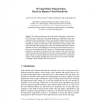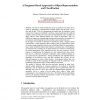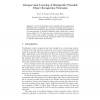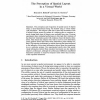98
Voted
BMCV
2000
Springer
15 years 5 months ago
2000
Springer
First IEEE International Workshop on Biologically Motivated Computer Vision, Seoul, Korea (May 2000). There is considerable evidence that object recognition in primates is based o...
111
Voted
BMCV
2000
Springer
15 years 5 months ago
2000
Springer
Abstract. We apply independent component analysis (ICA) for learning an efficient color image representation of natural scenes. In the spectra of single pixels, the algorithm was a...
83
Voted
BMCV
2000
Springer
15 years 5 months ago
2000
Springer
108
Voted
BMCV
2000
Springer
15 years 5 months ago
2000
Springer
We here describe a view-based system for the pose-independent representation of objects without making reference to 3-D models. Input to the system is a collection of pictures cov...
158
click to vote
BMCV
2000
Springer
15 years 5 months ago
2000
Springer
In this paper we propose a new method for extracting line segments from edge images. Our method basically follows a line segment grouping approach. This approach has many advantage...
88
Voted
BMCV
2000
Springer
15 years 5 months ago
2000
Springer
90
Voted
BMCV
2000
Springer
15 years 5 months ago
2000
Springer
The paper is a short tutorial on the multiscale differential geometric possibilities of the front-end visual receptive fields, modeled by Gaussian derivative kernels. The paper is ...
89
Voted
BMCV
2000
Springer
15 years 5 months ago
2000
Springer
While a great deal of experimental evidence supports the Reichardt correlator as a mechanism for biological motion detection, the correlator does not signal true image velocity. Th...
99
Voted
BMCV
2000
Springer
15 years 5 months ago
2000
Springer
Recent psychological and neurological evidence suggests that biological object recognition is a process of matching sensed images to stored iconic memories. This paper presents a p...
91
Voted
BMCV
2000
Springer
15 years 5 months ago
2000
Springer
The perception and recognition of spatial layout of objects within a three-dimensional setting was studied using a virtual reality (VR) simulation. The subjects' task was to d...




